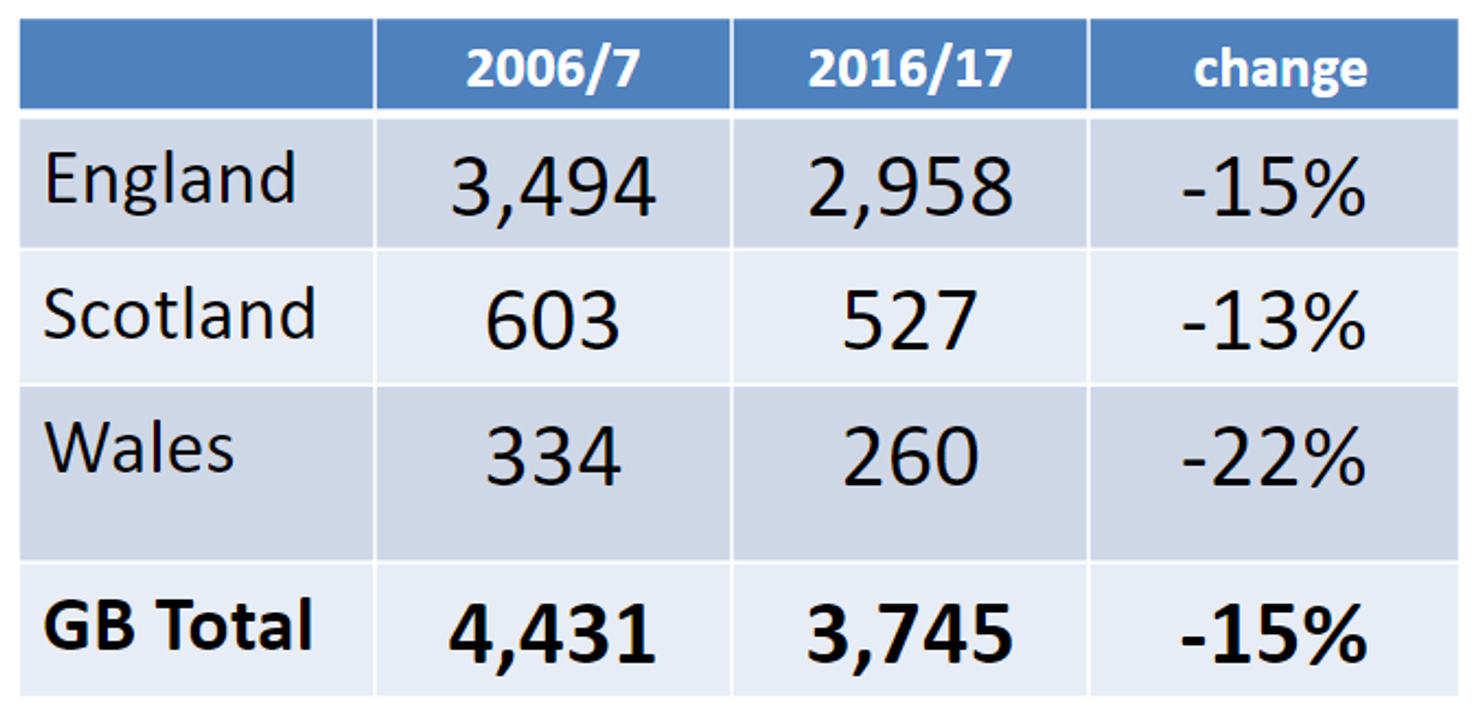Libraries in numbers

At the start of this project one of the first pieces of information I wanted to look at was simply the number of public libraries in the UK. Figures from CIPFA (published by CIPFA in 2017) provide not only the numbers, but the extent of decline in the sector.The table above shows the number of public libraries open for more than 10 hours per week.
In England, the number of libraries open for more than 10 hours has decreased by a substantial 15%: a drop of 536 public libraries. In Scotland there is a public narrative that austerity cuts have not (as yet) been as dramatic as experienced south of the border. Yet reductions to library services have been equally significant, with a loss of 13% from the public library estate – or 76 libraries – open more than 10 hours a week. In Wales the reduction in services amounts to even more. It should also be noted that these figures do not provide a full picture since not all local authorities made a return (more than half of local authorities in Wales did not make a full submission. The figures also include libraries which are now ‘community managed’: in 2016/17 ‘community managed’ libraries totalled 350 (335 in England, 8 in Wales and only 7 in Scotland).
These are not figures to celebrate.
However, like using book borrowing to determine how public libraries are valued, the number of public libraries are a rather blunt tool for understanding the shifting dynamics of the library estate. First, they say nothing of the motivations and rationale for closure or service reduction. Austerity, and reduced funding, is a likely key factor. But what is the squeezing point – the cost of staff, the cost of building maintenance, the quality of the stock (that is financially poor services becoming poor in quality and community investment)? We also see nothing within these numbers of the tremendous investment taking place in libraries services, where library closures or service reduction are part of the managed strategic plan for ‘future proofing’ the library services, and providing the means through which maintain a smaller, yet higher quality service provision.
The figures also tell us nothing of how local communities have experienced closure or service reduction. The Cost of the Cuts report by Annette Hastings and colleagues in 2015 examined how austerity measures were, at that time, affecting local government and communities. It concluded:
Cuts to local authority budgets are having a profound effect on the services people receive. The poorest communities and residents are being hardest hit and those least able to cope with service withdrawal are bearing the brunt.
Critically, what they found was that the impact of service reductions accumulate quicker in poorer areas, with better-off service users being more able to protect themselves from the worst impacts of the cuts. Thus, a middle class family with a car or good access to transport may be happy to travel to the next town or city centre to use an alternative library services. Likewise, parents and carers with greater disposable incomes will be able to purchase the services typically offered by libraries. They have, in turn, capital through which to construct social networks in these private spaces. Cut of the Costs also highlights the way that small ‘savings’ can make a big difference to poorer individuals. A public library closing at 5pm, instead of 8pm, may not seem like a huge change or reducation in service. However it could, depending on local context and local needs, have a significant affect on well-being.
(Data source: Source: https://uklibrarynews.wordpress.com/2017/12/18/initial-cipfa-data-analysis-by-tim-coates-december-2017/ )
(Data source: Source: https://uklibrarynews.wordpress.com/2017/12/18/initial-cipfa-data-analysis-by-tim-coates-december-2017/ )



